The Ansoff Matrix is a strategic tool that helps businesses develop their growth and strategy to develop their audience in some specific product. Companies need to adapt this matrix, especially if they are startups to see their potential market growth among other companies. So, in this article, we will provide eight practical examples of how top companies used the Ansoff Matrix. Further, we show you how to use the Ansoff Matrix template using Boardmix, an intuitive, AI-powered tool to improve your business strategy.
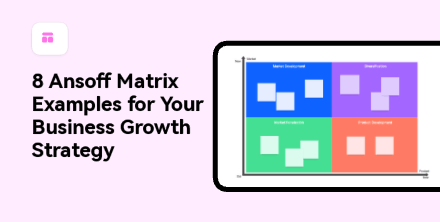
What Is the Ansoff Matrix
Ansoff Matrix is named after a mathematician and a business manager named H. Igor Ansoff. It was introduced in 1957. The primary goal of this matrix is to help out businesses analyze the potential risks that are associated with different growth initiatives.
In general terms, the Ansoff Growth Matrix is also known as the Product or Market Expansion Grid. Companies use this matrix for the utilization of strategic planning to grow in the future. It is often utilized by management teams to help executives, senior managers, and marketers assess and plan future growth. It is represented in the form of a two by two matrix and it highlights four distinct growth strategies based on product and market.
What Are the 4 Growth Strategies of Ansoff
The basic 4 growth strategies of the Ansoff model are as follows:
- Market Penetration: Help in increasing the selling of existing products in the current market.
- Market Development: Based on selling existing products in a new market.
- Product Development: Focus on selling new products in an existing market.
- Diversification: Sell new products in a new market.
Market Penetration
Market penetration is the most basic and the least risky strategy among all other factors. In this factor, the company sells the existing products in the current market where the company already has potential relationships. This approach can be achieved by optimizing the distribution process, offering new discounts on existing items, enhancing marketing efforts, and acquiring a competitor in the same processing market.
Market Development
Another least risky option after the market penetration and market growth. In this factor, a company focuses on selling the existing products into a newly developed market or in another customer segment. This factor can be achieved by targeting different customer demographics and expanding the regional or foreign market. This can also include targeting the international market.
Product Development
In the product development factor, the main focus is on expanding the company’s market share with its existing customers/ audience. This approach capitalizes on brand loyalty and involves investing in research. This also consists of the development to create entirely new products, and acquiring rights to sell another company's products, or sometimes the branding of white-label products from some third-party manufacturers.
Diversification
The diversification factor comes with a high level of risk. In this strategy, a company needs not only product development but also market development. Diversification is further divided into two main strategies:
- Related Diversification: This type involves seeking synergies between the existing business and the new product/market. For example, a shoe producer venturing into producing leather car seats could potentially benefit from sourcing raw materials more efficiently due to similarities in the production process.
- Unrelated Diversification: In this type, the focus is on entering into a new product/market where there are limited or no synergies with the existing business. An example would be the same shoe producer investing heavily in completely unrelated consumer packaged goods to diversify its revenue sources and reduce dependence on the cyclical shoe business.
8 Ansoff Matrix Examples
Some of the significant Ansoff Matrix examples of companies adapting the Ansoff model are:
Coca-Cola
Coca-Cola is a well-known brand that was established in the United States over the ages. The main product of this company was a soft drink. By the time the company started expanding its product portfolio and introduced different products like Diet Coke and Coca-Cola Zero. This company expanded its business to the global markets after seeking a large customer demand. You will also notice other beverages of this company like coffee and water.
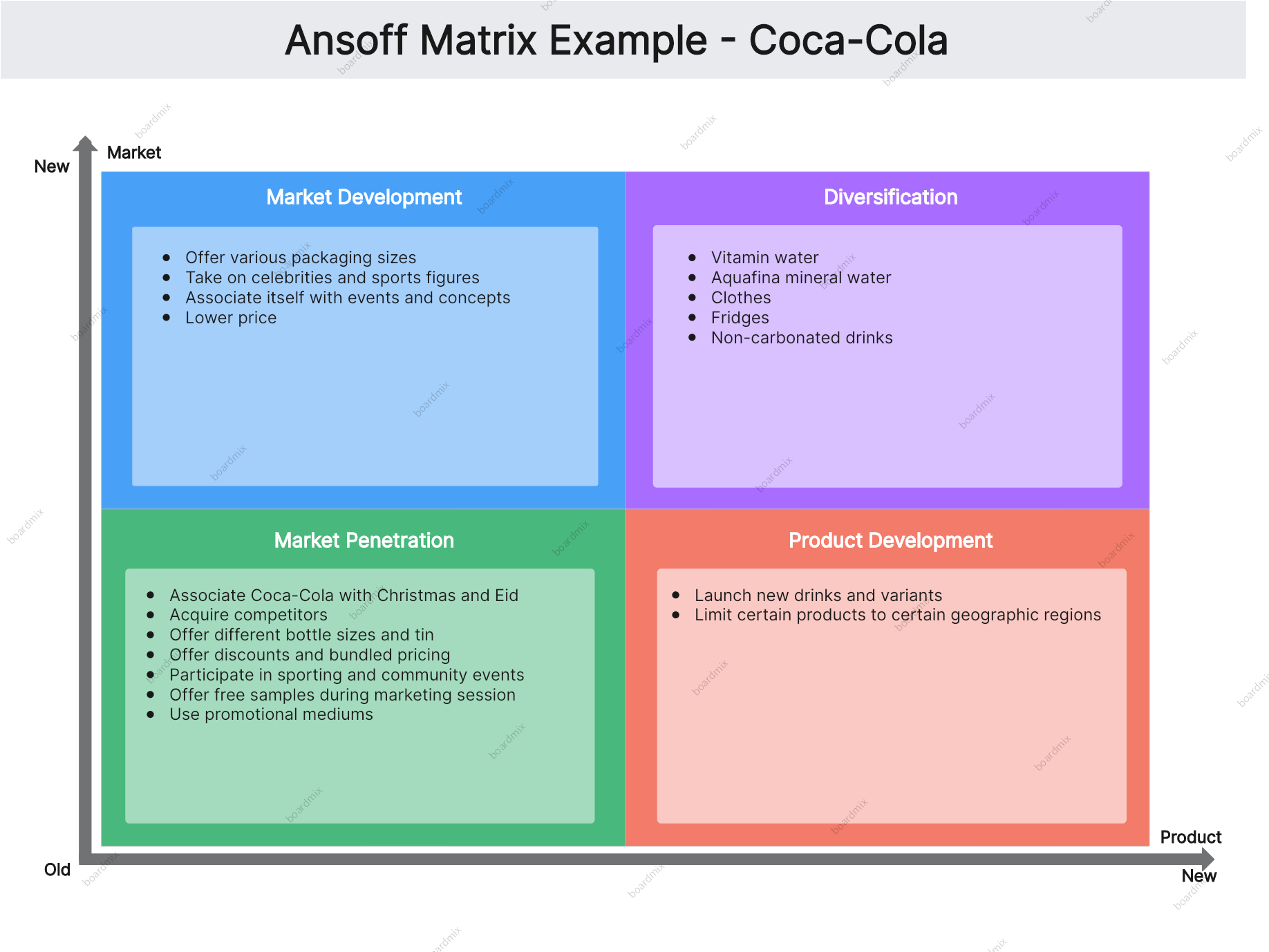
PepsiCo
Another famous company named PepsiCo started in the U.S. market. This company also started its business with a flagship product named Pepsi. Over time, it produced different variants like Diet Pepsi and Pepsi Max. After noticing the potential, PepsiCo expanded its customer base to foreign markets. To further expand its market, PepsiCo introduced other non-beverages through different brands like Frito-Lay and Quaker.
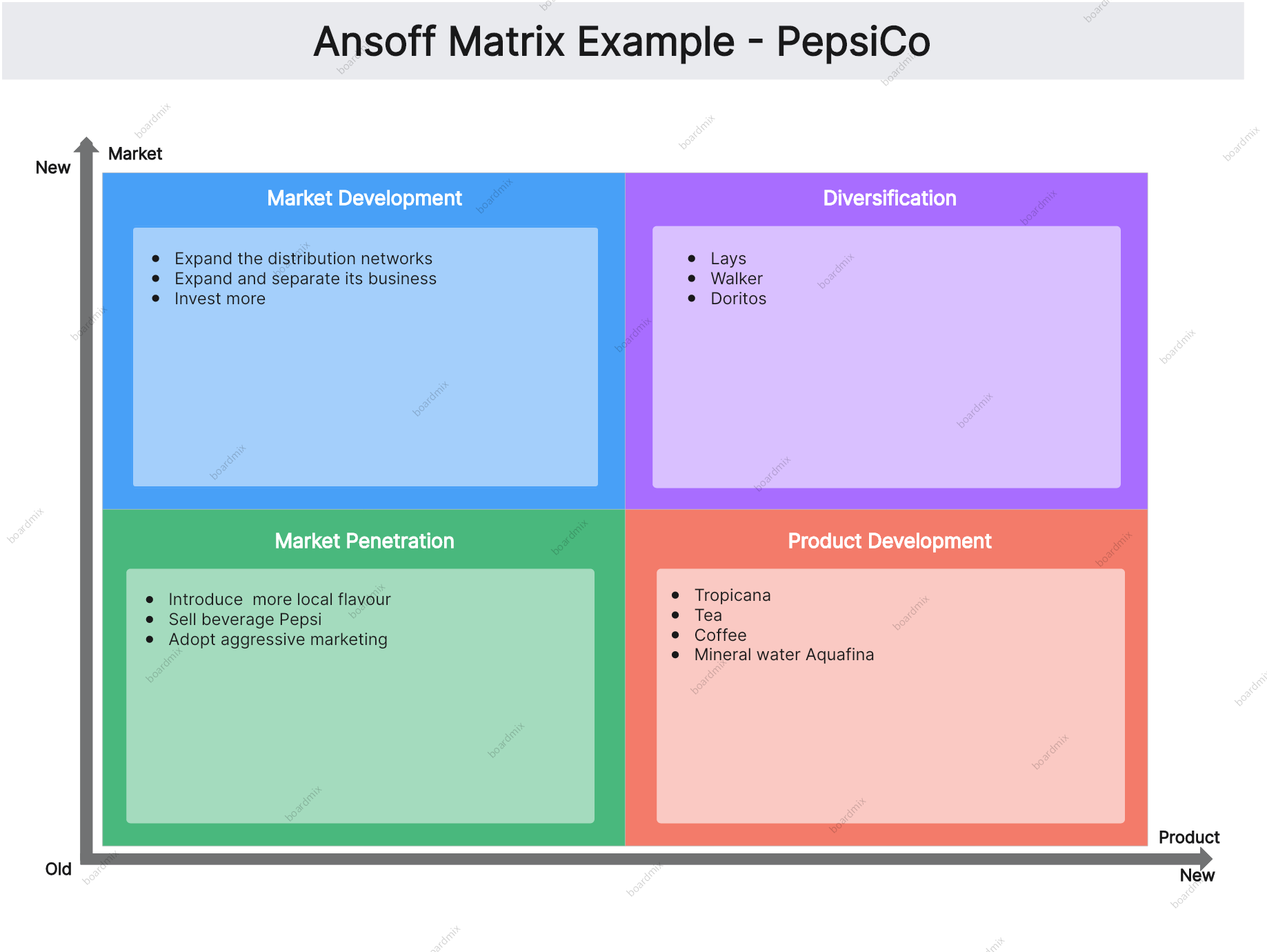
Apple
Apple started its growth by entering the technology market with its unique and innovative Apple I and II computers. Due to the successful selling rate of these products, Apple further brought the Macintosh computers. Moreover, it stepped into the market with mobile phones and tablet industry through iPhone and iPad. Through every single product, Apple challenged the already existing market companies. Apple also started to offer different services like Apple Music, Apple TV, and iCloud to expand the business scope.

Starbucks
Starbucks began as a premium coffee shop in the U.S. Later on it started innovating its menu with unique products like Frappuccinos and seasonal drinks. The company didn't limit itself to the domestic market. But over time it launched outlets in various international locations. Starbucks further broadened its business by introducing consumer-packaged goods and ready-to-drink beverages sold outside its stores.

Nestlé
Nestlé's initial product offerings were condensed milk and infant formula. They gradually added more products to their portfolio, such as Nescafé coffee, chocolate, and bottled water. Not stopping at being a domestic giant, Nestlé ventured into global markets.

McDonald's
McDonald's began as a fast-food restaurant in the U.S. Gradually introducing new items like the Big Mac and McNuggets. They took their popular food concept to international markets, adapting different cuisines. McDonald's also began offering healthier options.
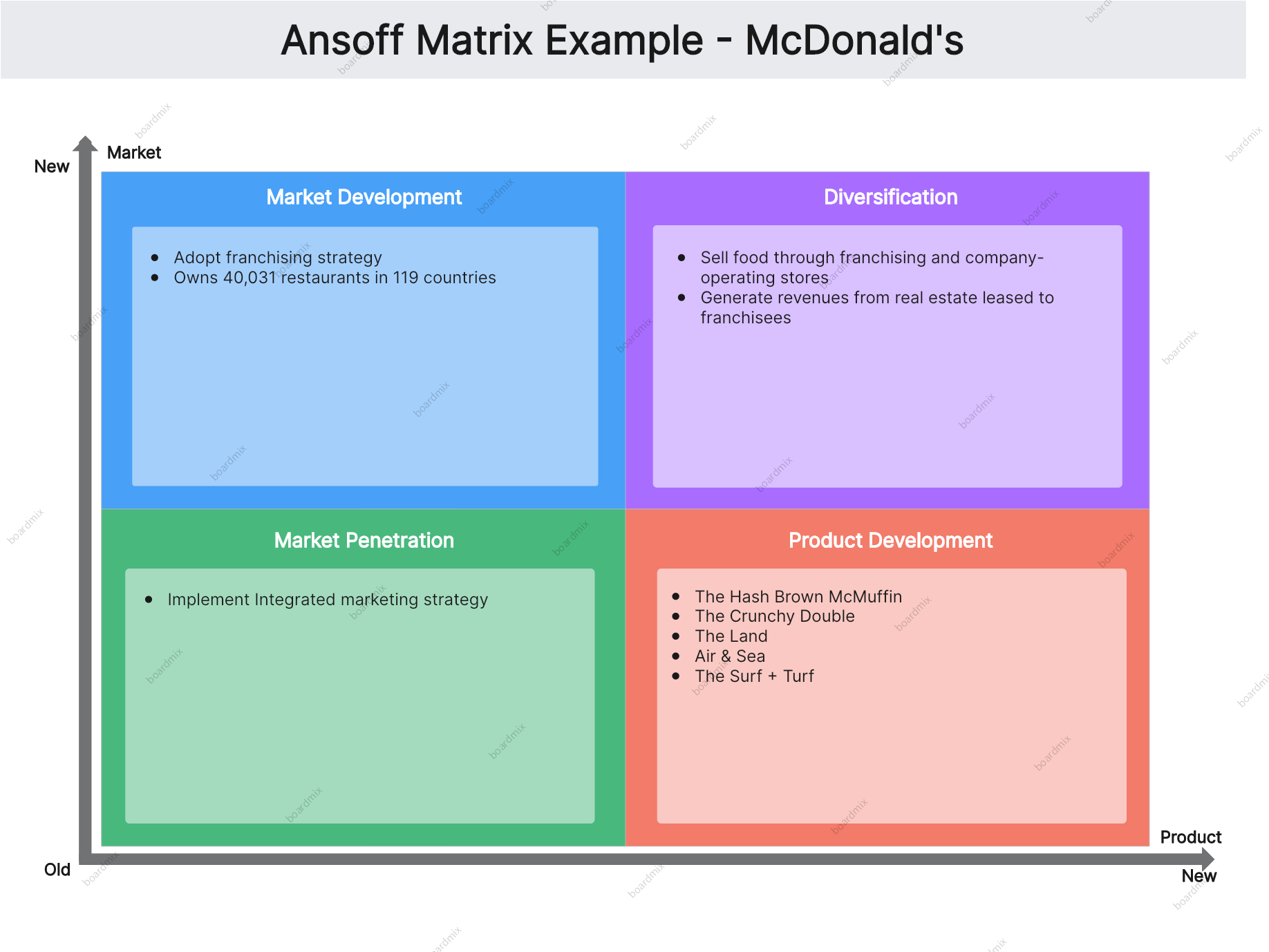
IKEA
IKEA's business started by providing affordable furniture to the Swedish market. The company introduced unique products like flat-pack furniture. It took its business model to foreign markets. IKEA also expanded into the food service industry with its in-store restaurants.

Xiaomi Inc
Xiaomi started its journey in the Chinese market with high-quality, affordable smartphones. The company gradually broadened its product line to include smart TVs and laptops. Xiaomi also went global, extending its reach, particularly in Asian and European markets.

How to Use Ansoff Matrix
To use the Ansoff Growth Matrix, you can follow the down-written tips and tricks. So,
Common Tips
Some of the most common tips that this matrix uses are:
Utilizing some ready-made templates: Boardmix offers a premade Ansoff Matrix template that helps you simplify the initial setup process.
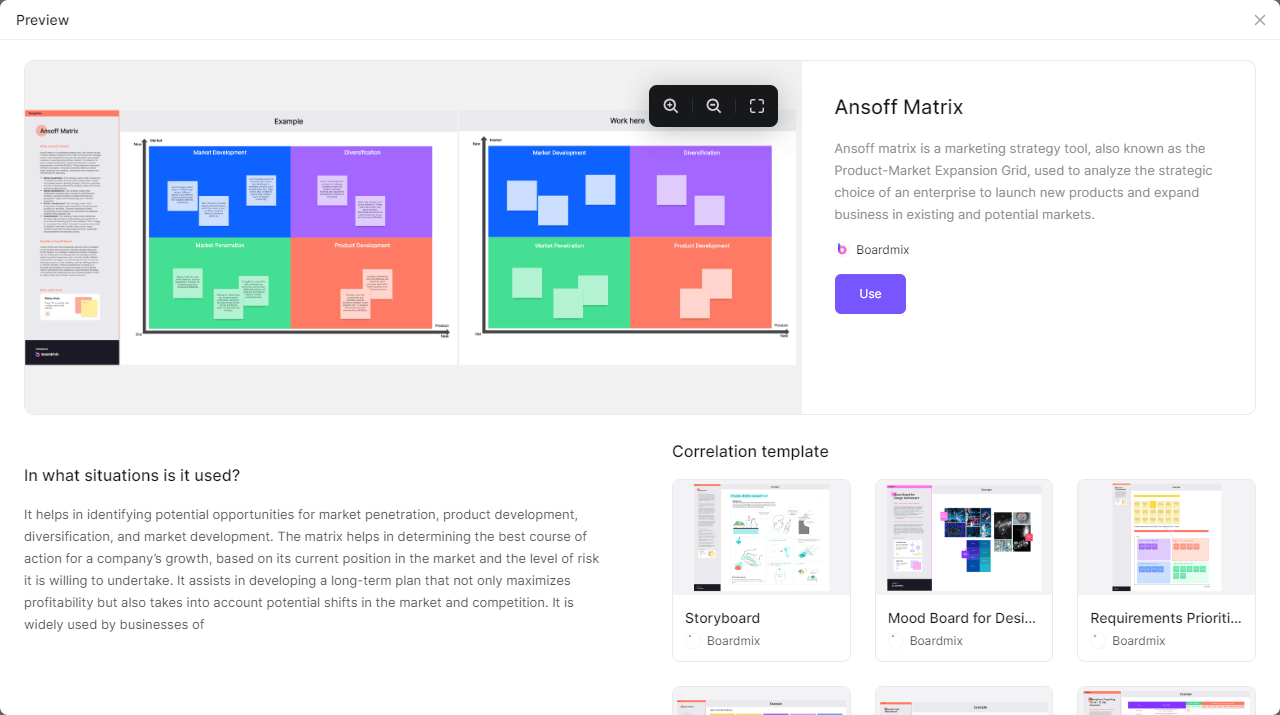
Leverage the AI Assistant: By feeding your business details to Boardmix's AI Assistant, you can help populate the Ansoff Matrix. Furthermore, you need to identify the potential growth strategies in market penetration, development, product development, and diversification.
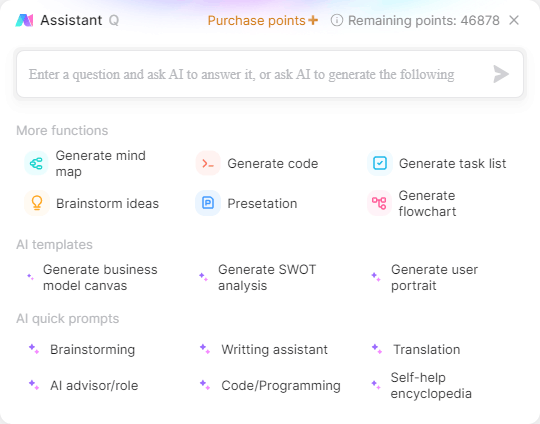
Review and adjust the Matrix: Once the AI assistant has filled out the matrix, take the time to review and align it with your business strategy and goals. You can customize the matrix as needed.
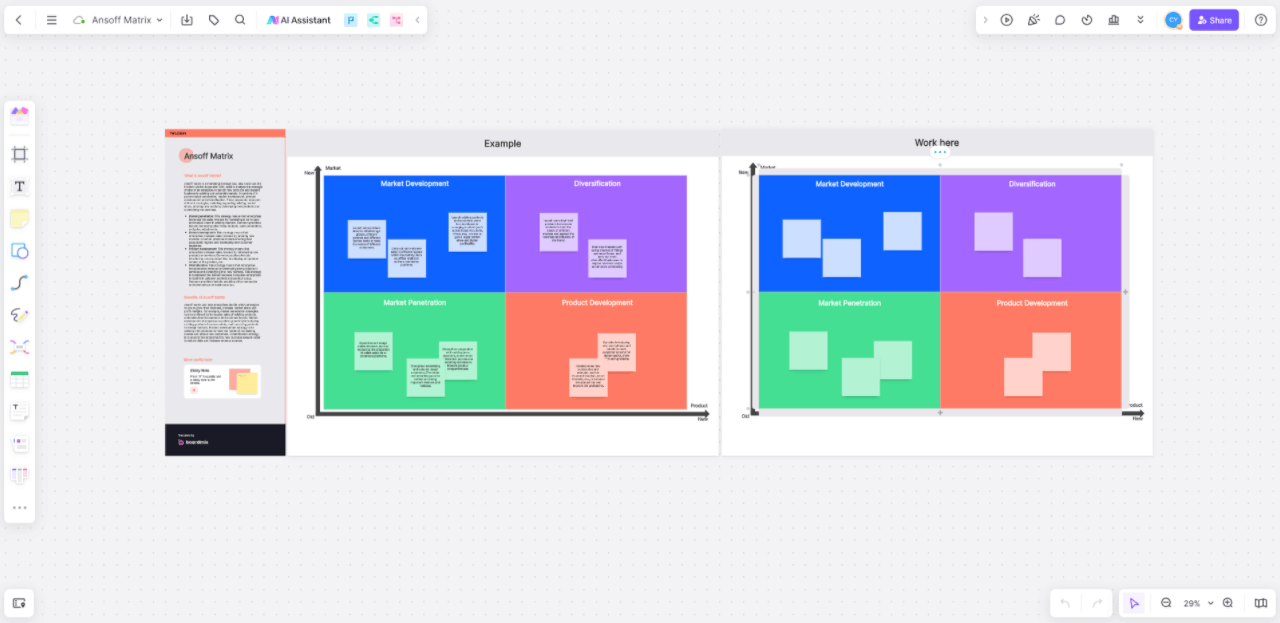
Develop a strategy: Use the insights gathered from the matrix to formulate a comprehensive growth strategy for your business.
Implement, monitor, and adjust: With the project management tools provided by Boardmix. put your strategy into action, and track progress. Finally, make necessary adjustments along the way.
Create an Ansoff Matrix for Your Business with Boardmix
In Boardmix, there are different readymade templates. In it, you can also find Ansoff templates, paired up with AI Assistant. You can easily streamline the strategic planning process of your business with it.

All that you need to do is to put your key details about the current products, markets, and growth ambitions, delineating opportunities for market penetration, market development, product development, and diversification. It is super important to properly review this information and understand the implications of each matrix.
Furthermore, you need to align these insights with the existing business strategies and objectives. The best part about Boardmix is that, with it you're not confined to the AI assistant's initial recommendations. You can customize the Ansoff Matrix based on your in-depth understanding of your business and industry. Boardmix goes beyond strategy formation, offering project management tools to assist in implementing your plan. Moving forward you can monitor its progress, and make necessary adjustments. Thus, catalyzes strategic thought and discussion, it allows you to explore various strategic paths and understand their potential impact on your business growth.
Final Conclusion
In summary, the Ansoff Matrix can catalyze strategic thought and discussion; once it gets combined with Boardmix's AI Assistant. It can easily empower you to make informed decisions and drive your business toward sustainable growth and success.









